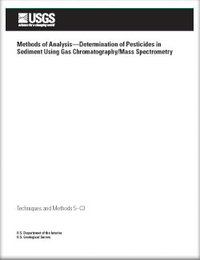A method for the determination of 119 pesticides in environmental sediment samples is described. The method was developed by the U.S. Geological Survey (USGS) in support of the National Water Quality Assessment (NAWQA) Program. The pesticides included in this method were chosen through prior prioritization. Herbicides, insecticides, and fungicides along with degradates are included in this method and span a variety of chemical classes including, but not limited to, chloroacetanilides, organochlorines, organophosphates, pyrethroids, triazines, and triazoles. Sediment samples are extracted by using an accelerated solvent extraction system (ASE®, and the compounds of interest are separated from co-extracted matrix interferences (including sulfur) by passing the extracts through high performance liquid chromatography (HPLC) with gel-permeation chromatography (GPC) along with the use of either stacked graphitized carbon and alumina solid-phase extraction (SPE) cartridges or packed Florisil®. Chromatographic separation, detection, and quantification of the pesticides from the sediment-sample extracts are done by using gas chromatography with mass spectrometry (GC/MS). Recoveries in test sediment samples fortified at 10 micrograms per kilogram (μg/kg) dry weight ranged from 75 to 102 percent; relative standard deviations ranged from 3 to 13 percent. Method detection limits (MDLs), calculated by using U.S. Environmental Protection Agency procedures (40 CFR 136, Appendix B), ranged from 0.6 to 3.4 μg/kg dry weight.


